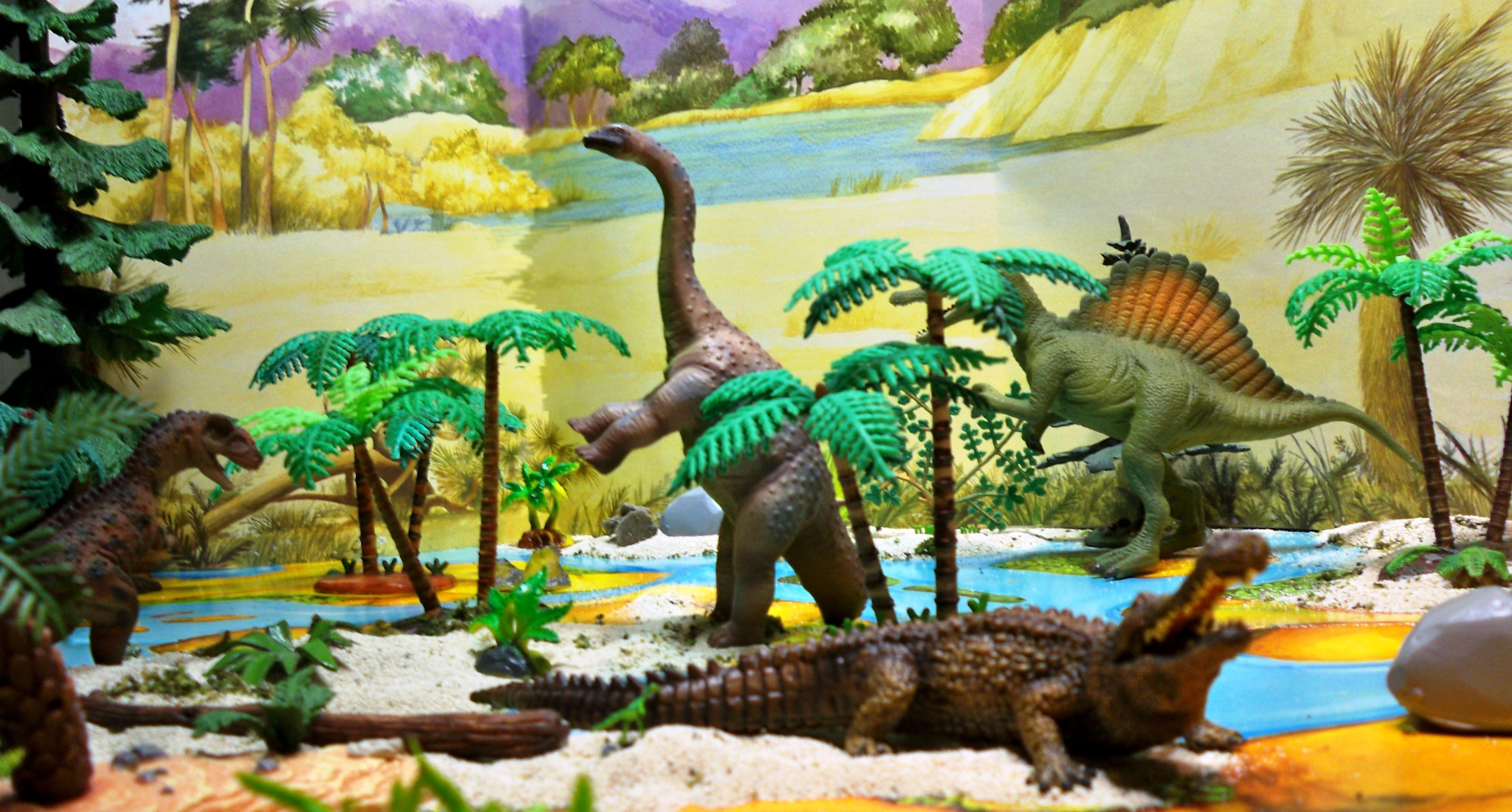 Procon Spinosaurus, Rugops, Paralititan and Sarcosuchus.
Procon Spinosaurus, Rugops, Paralititan and Sarcosuchus. Mid Cretaceous Africa
from the Dinosaur Collector
update 111009
Spinosaurus appears to have inhabited an early mangrove-like environment of vegetated tidal flats and tidal channels, and co-existed with Carcharodontosaurus, Rugops, Paralititan. and Sarcosuchus. The were a wide range of crocilians the most impressive was Sarcosuchus.
 Procon Spinosaurus, Rugops, Paralititan and Sarcosuchus.
Procon Spinosaurus, Rugops, Paralititan and Sarcosuchus.
The bones of Spinosaurus were destroyed in World War II but it could have been larger than Tyrannosaurus. The teeth are those of a fish eater and are like those of fish eating crocs. It may have even been a prey item for Carcharodontosaurus. The original Spinosaurus bones were destroyed by Allied bombs in 1944 so size is problematic. Examination of two skull fragments suggests that Spinosaurus could have been up to 55 feet long. This is bigger any other theropod dinosaur. When a complete skeleton is found Spinosaurus it could prove to be the largest meat eater
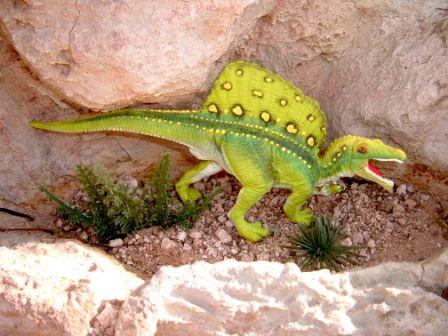
Wild Safari Spinosaurus custom painting PHOTO AND ART WORK BY....Fred R Hinojosa
The large spines on the back (up to 1.8 m/6 ft long) supported a skin sail that may have served as a heat exchanger or for communication or display. Spinosaurus teeth were conical, without serrations and straight, not curved like most carnosaurs. It was probably a scavenger as the sail would have been too easily damaged to risk attacking. Some estimate its size as large as 17 m (53 ft), making it potentially the longest theropod.
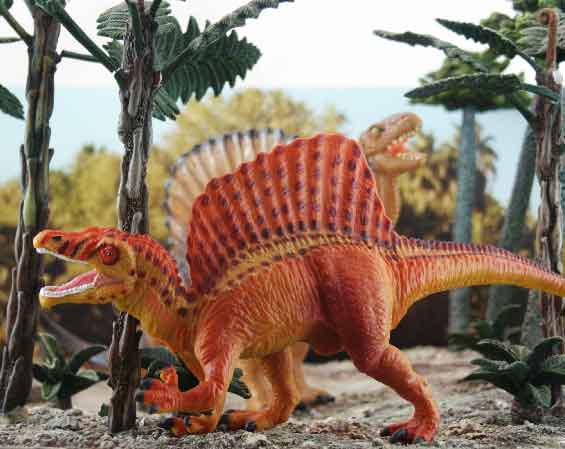 ..
..
Wild Safari and Carnegie Safari Spinosaurus . Early figures tended to look like T rex with a fin. The Carnegie Safari version keeps more conservative colors.
| Reconstruction is based on Baryonyx and other spinosaurids, as no limb material has ever been attributed to Spinosaurus itself. It had elongated crocodilian jaws, conical teeth and raised nostrils. A fish diet seems likely but such a large animal would have also taken advantage of carrion and opportunist predation and evidence of fish scales has been found with Baryonyx. | The fishing must have been good since the there are a wide range of crocodilians some like Sarcosuchus getting large enough to take down dinosaurs. This had led to speculation that Spinosaurus my have been aquatic. | |
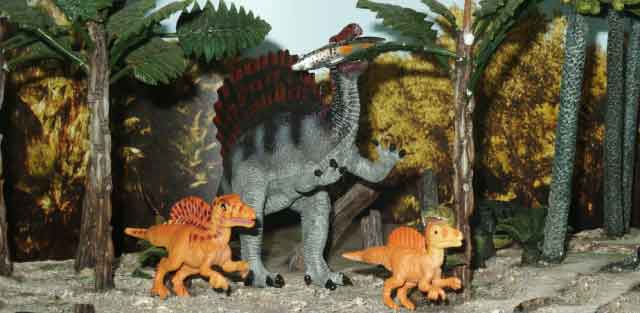 |
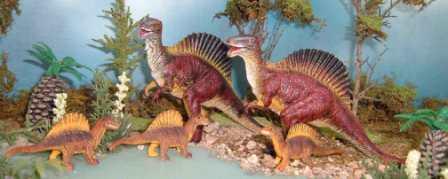 |
|
| New 2007 repainted Carnegie Safari Spinosaurus, Wild Safari and Dino Toob babies. | custom painting PHOTO AND ART WORK BY....Fred R Hinojosa |
Spinosaurs are characterized by conical teeth with very small serrations, with the front teeth fanning out. Spinosaurid teeth are also much more oval in cross-section than those of other theropods. They had long snouts, relatively straight necks and perhaps (Baryonyx, Irritator, at least) a single nasal crest. The first finger of the hand had a very large claw. These physical characters strongly suggest that these dinosaurs may have eaten fish, either exclusively, or as a large part of their diet of meat.

Spinosaurus from Carnegie Safari and Schleich. Deinosuchus from Carnegie Safari
There is considerable debate about which genera, if any, should be included in Spinosauridae other than Spinosaurus itself. Current thinking following the discovery of the new African species is to divide spinosaurids into 2 sub-families, the Baronychinae and the Spinosaurinae. Baronychines (Baryonyx, Suchomimus) have more (about 30) and smaller dentary teeth and a blade-like keel on the anterior dorsal centra, while the spinosaurines (Spinosaurus, Irritator) have very straight teeth without serrations.
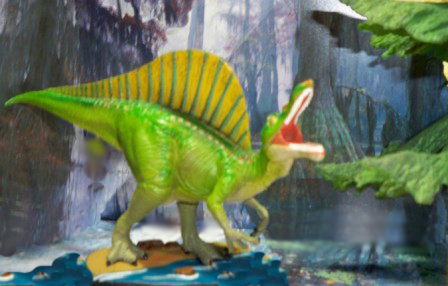
Colorata Spinosaurus
Spinosaurus was popularized by the third Jurassic Park movie. It has a distinctive look although often in older or low end sets it looks like a T rex with a fin. The head should have a look more like that of a croc. It may replace the fin backed Dimetrodon as a regular in play sets. Recent although fragmentary finds suggest this is a very large animal but reconstruction is still very hypothetical.
Click on the Site A icon to the right for Dioramas organized by period or by manufacturer.